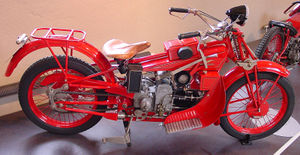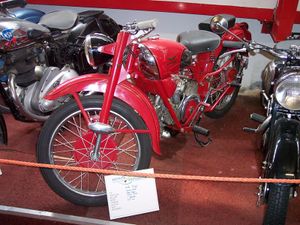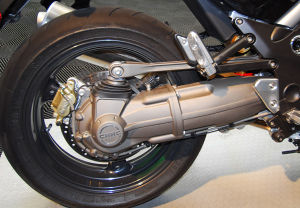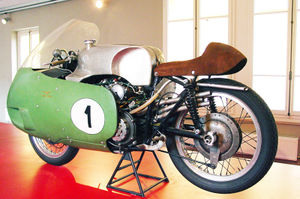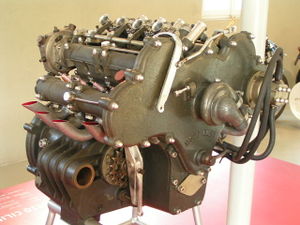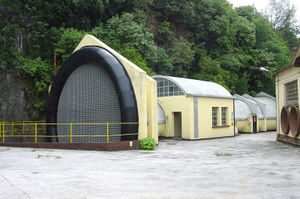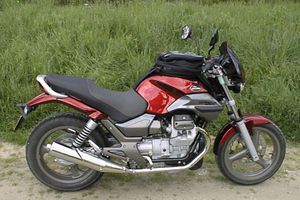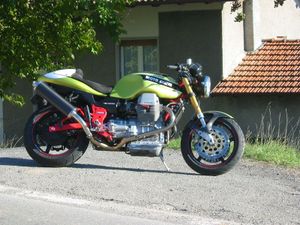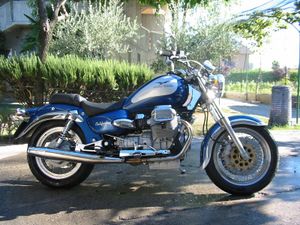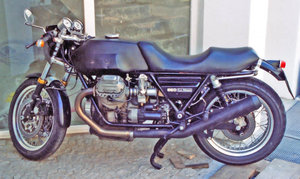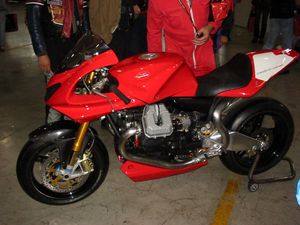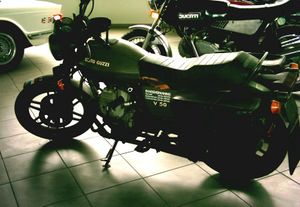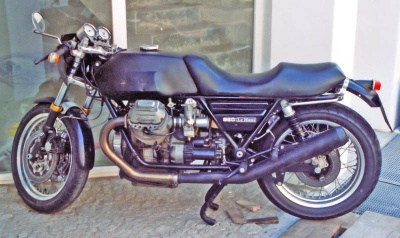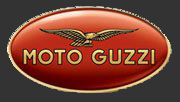Moto Guzzi
| Moto Guzzi | |
|---|---|
| Company type | Unico Azionista (Wholly Owned Subsidiary) |
| Slogan | Moto Guzzi: Una Storia Importante (An Important Story) |
| Founder | Carlo Guzzi (1889–1964), Giovanni Ravelli ( -1918), Giorgi Parodi (1897-1955) |
| Foundation | 1921 |
| Location city | Italy Mandello del Lario |
| Location country | |
| Key people | Daniele Bandiera ceo |
| Num employees | |
| Industry | Motorcycle |
| Products | |
| Revenue | |
| Parent | Piaggio & Co. SpA |
| Owner | |
| Net income | |
| Homepage | www.motoguzzi.it |
The Italian motorcycle manufacturer Moto Guzzi (aka "Guzzi") has endured from the industry's infancy to its place today as the oldest European manufacturer in continuous motorcycle production. Guzzi is now one of seven brands owned by Piaggio & Co. SpA, Europe's largest motorcycle manufacturer and the world's fourth largest motorcycle manufacturer by unit sales.
Established in 1921 in Mandello del Lario, Italy, Moto Guzzi has led Italy's motorcycling manufacture, enjoyed prominence in world-wide motorcycle racing, and led the industry in ground-breaking innovation — for the greater part of its history.
Today Moto Guzzi impresses its heritage on a range of motorcycles in touring, cruising, racing and naked configurations — each with the company's iconic, air-cooled 90° V-twin engines.
History
Not unlike Harley-Davidson and other storied motorcycle manufacturers that have survived for decades, Moto Guzzi has experienced a series of business cycles and a series of ownership arrangements — some complex, some brief, some with enduring legacy.
Three themes connect the chapters in Moto Guzzi's history: the importance of racing, the importance of innovation and the ongoing struggle to leverage the company's heritage -- the seminal passion for motorcycles that gave rise to the company in 1921.
1921 to 1966 ~ The Origins of Moto Guzzi
Moto Guzzi was conceived by two airplane pilots and their mechanic serving in the Corpo Aeronautico Militare (the Italian Air Corp, CAM) during the first World War: Carlo Guzzi (1889–1964), Giovanni Ravelli (d. 1918) and Giorgi Parodi (1897–1955). By happenstance assigned to the same Miraglia Squadron based outside Venice, the three became close, despite starkly different socio-economic backgrounds. The trio envisioned creating a motorcycle company after the war. Guzzi would engineer the motor bikes, Parodi (scion of wealthy Genovese ship-owners) would finance the venture, and Ravelli (already a famous pilot and motocycle racer) would promote the bikes with his racing prowess. Guzzi and Parodi (along with Parodi's brother) formed Moto Guzzi in 1921. Ravelli, ironically, had died just days after the war's end in an airplane crash. Such was his role in creating the idea of the motorcycle company, that Guzzi and Parodi immortilized Ravelli by taking the CAM insignia, the soaring eagle, for Moto Guzzi's logo.
Carlo Guzzi and Giorgio Parodi — along with Giorgio's brother Angelo — created a privately held silent partnership "Società Anonima Moto Guzzi" on 15 March 1921 -- for the purpose of (according to the original articles of incorporation) "the manufacture and the sale of motor cycles and any other activity in relation to or connected to metallurgical and mechanical industry".
The formation of the company hinged on an initial loan of two thousand Lira from the Parodis' father, Emanuele Vittorio, which he gave on 3 January 1919, offering the balance of the loan upon his review of the project's progress:
- "Dear Giorgio, you can let both your partners know that I will offer you for your first 1.500 or 2.000 Lire. Although with the condition that the sum, under no circumstances, shall be increased. Likewise, I reserve the right to supervise your progress before giving my agreement to this project."
The company was legally based in Genoa, Italy, with its headquarters in Mandello. The very earliest motorcycles bore the name G.P. (Guzzi-Parodi), though the marque quickly changed to Moto Guzzi. As the only actual shareholders, the Parodi's wanted to shield their shipping fortunes by avoiding confusion of name G.P. with Giorgio Parodi's initials. Carlo Guzzi initially received royalties for each motorcycle produced, holding no ownership in the company that bore his name. In 1946 Moto Guzzi formally incorporated as Moto Guzzi S.p.A. with Giorgio Parodi as chairman.
From the 1930s until the 1960s, Moto Guzzi was the largest marque among Italian motorcycle manufacturers. Carlo Guzzi's first engine design was a horizontal single that dominated the first 45 years of the company's history in various configurations. Through 1934, each engine bore the signature of the mechanic who built it. As originally envisioned, the company used racing to promote the brand. Moto Guzzi went on to win 3,329 official races, 8 World Championships, 6 Constructor's Championships and 11 Isle of Man TT victories.
Until the mid 1940s, the traditional horizontal four-stroke single cylinder 500 cc engines outfitted with one overhead and one side valve (also known as: IOE, inlet over exhaust or F-head) were the highest performance engines Moto Guzzi sold to the general public. By contrast, the company supplied the official racing team and private racers with higher performance racing machines with varying overhead cam, multi-valve configurations and cylinder designs.
In the 1935 Isle of Man TT, Moto Guzzi factory rider Stanley Woods performed an impressive double victory with wins in the Lightweight TT as well as the Senior TT.
In the 1950s, Moto Guzzi led the world of Grand Prix motorcycle racing. With durable and lightweight 250 cc and 350 cc bikes designed by Giulio Carcano, the firm dominated the middleweight classes. The factory won five consecutive 350 cc world championships between 1953 and 1957. In realizing that low weight alone might not continue to win races for the company, Carcano designed the V8 500 cc GP race bike — whose engine was to become one of the most complex engines of its time. Despite the bike's having led many races and frequently posted the fastest lap time, it often failed to complete races because of mechanical problems. Ultimately, the V8 was not developed further as Moto Guzzi withdrew (together with the main competitors Gilera and Mondial) from racing after the 1957 season — citing escalating costs and diminishing motorcycle sales.
The period after World War II was as difficult in Mandello del Lario as it was elsewhere in post-war Europe. The solution was production of inexpensive, lighter cycles. The 1946 "Motoleggera", a 65 cc lightweight motorcycle became very popular in post-war Italy. A four-stroke 175 cc scooter known as the "Galletto" also sold well. Though modest cycles for the company, the lighter cycles continue to feature Guzzi's innovation and commitment to quality. The step-through Galletto initially featured a manual, foot-shifted three-speed (160 cc) configuration then later a four-speed (175 cc) set-up by the end of '52. The displacement was increased to 192 cc in 1954 — electric start was added in 1961.
Moto Guzzi was somewhat trapped in its endeavors to penetrate the important scooter market as motorcycle popularity waned after WWII. Italian scooter competitors would not tolerate an incursion from Moto Guzzi. By innovating the new large-wheeled scooter, Guzzi competed less directly with manufacturers of small-wheeled scooters such as Piaggio (Vespa) and Lambretta. To illustrate the delicate balance within the Italian post-war motorcycle and scooter markets, when Guzzi developed their own prototype for a small-wheeled scooter, Lambretta retaliated with a prototype for a small V-twin motorcycle — threatening to directly compete on Moto Guzzi's turf. The two companies compromised: Guzzi never produced their small-wheeled scooter and Lambretta never manufactured the motorcycle. Notably, the drive train that Lambretta made in their 1953 motorcycle prototype remarkably resembles the V-twin + drive shaft arrangement that Guzzi developed more than ten years later, ultimately to become iconic of the company. The Casa Lambretta Museum in Rodano Italy has both Lambretta's two prototype motorcycles and the single prototype Guzzi small-wheeled scooter on display.
By 1964, the company was in full financial crisis. Emanuele Parodi and his son Giorgio had died, Carlo Guzzi had retired to private life, and direction passed to Enrico Parodi, Giorgio's brother. Carlo Guzzi died on November 3rd, 1964 -- in Mandello, after a brief hosptial stay in Davos.
1967 to 1973 ~ The SEIMM Years
In February 1967, SEIMM (Società Esercito Industrie Moto Meccaniche), a state controlled receiver, took ownership of Moto Guzzi. The SEIMM oversight saw Moto Guzzi adapting to a cultural shift away from motorcycles to automobiles. The company focused on popular lightweight mopeds including the Dingo and Trotter — and the 125 cc Stornello motorcycle. Also during the SEIMM years that Guzzi developed the 90° V twin engine — designed by Giulio Cesare Carcano — which would become iconic of Moto Guzzi.
Though Moto Guzzi has employed engines of myriad configurations, none has come to symbolize the company more than the air-cooled 90° V-twin with a longitundinal crankshaft orientation and the engine's transverse cylinder heads projecting prominently on either side of the bike. The original V-twin was designed in the early 1960s by engineer Giulio Cesare Carcano, designer of the DOHC V8 Grand Prix racer. The air-cooled, longitudinal crankshaft, transverse cylinder, pushrod V-twin began life with 700 cc displacement and 45 hp -- designed to win a competition sponsored by the Italian government for a new police bike. The sturdy shaft-drive, air-cooled V-twin won, giving Moto Guzzi renewed competitiveness. This 1967 Moto Guzzi V7 with the original Carcano engine has been continuously developed into the 1200 cc, 80 hp versions offered today (2006). Lino Tonti redesigned the motor for the 1971 Moto Guzzi V7 Sport. This engine is the basis of the currently used 850 cc, 1100 cc and 1200 cc Guzzi engines. Notably, the longitudinal crankshaft and orientation of the engine creates a slight gyroscope effect, with a slightly asymmetrical behavior in turns.
A 4-valve version of the Carcano engine was created in the early 1990s and is currently used in the 1250 cc MGS-01 Corsa.
1973 to 2000 ~ The De Tomaso Years
After experiencing financial difficulties in the late 1960s, De Tomaso Industries Inc. (D.T.I. Group or DTI), manufacturer of the De Tomaso sports and luxury cars, owned by Argentinian industrialist Alejandro de Tomaso, purchased SEIMM (and thereby Moto Guzzi) along with Benelli and Maserati in 1973. Under Tamaso's stewardship, Moto Guzzi returned to profitability, though other reports suggest a period of limited investment in Moto Guzzi followed attributed to DTI using Moto Guzzi financially prioritizing their automotive ventures.
In 1979 a small block version of the air-cooled V-twin designed by engineer Lino Tonti was introduced as the V35. Radical when introduced, the design cut the weight from 548 kg of the contemporary 850 T3 to the 385 kg of the V35. The power of the original V35 at 35 bhp was competitive with engines of comparable displacement of the period — later larger versions (V50, V65, V75) were rapidly outclassed by competing water cooled engines. Notably, the Breva and Nevada today feature a descendent of Tonti's V35 engine: the 750 cc V-twin, rated at 48 bhp. With its ease of maintenance, durability and even, flat torque curve, the engine design remains suitable to everyday, real-world situations.
As Guzzi continued to develop the V-twin, power was increased in the mid 1980s when Guzzi created 4 valve versions of the "small block" series. Of these, the 650 and the 750 were rated at 60 bhp and 65 bhp respectively. The production of the 4-valve "small block" engines ended in the later 1980s.
Moto Guzzis have used an hydraulic integral brake system, where the right front disc works off the handlebar lever, while the left front and the rear disc work off the foot brake. Rudge-Whitworth used an early integrated, anti-lock, braking system in 1925.
The cartridge front fork used in Guzzi's motorcycles of the later 1970s and 1980s is a Guzzi invention. Instead of containing the damping oil in the fork it is in a cartridge. Oil in the fork is purely for lubrication.
Still under the De Tomaso umbrella, in 1988, Benelli and SEIMM merged to create Guzzi Benelli Moto (G.B.M. S.p.A. ). During this period, Moto Guzzi existed as an entity within the De Tomaso owned G.B.M., but in 1996 celebrated its 75th birthday and the return of its name to Moto Guzzi S.p.A. In 1996, De Tomaso became Trident Rowan Group aka TRG.
2000 to 2004 ~ The Aprilia Years
Under the helm of Ivano Beggio, Aprilia S.p.A acquired Moto Guzzi S.p.A on 14 April 2000 for $65 million. According to the original press release, the intention had been that Moto Guzzi would remain headquartered in Mandello del Lario, share Aprilia's technological, R&D capabilities and financial resources as well. The arrangement would remain short-lived, as Aprilia itself stumbled financially. At the same time Aprilia attempted to diversify in other areas of manufacturing, new Italian laws required helmets for motorcyclists and raising insurance rates for teenage motorcyclists, severely affected the company's profitability. Nonetheless, Aprilia had committed large sums to renovating the Mandello Moto Guzzi factory -- renovations that were ultimately completed. Notably, Ducati again made an offer for Moto Guzzi during Aprilia's financial difficulties (as it had before, when Aprilia had purchased Guzzi in 2000) -- other potential buyers included Kymco of Taiwan and Bombardier of Canada (Kymco reportedly making the highest offer). The Moto Guzzi assembly line closed for a short period in March of 2004, due to the financial difficulties.
2004 to 2007 ~ The Piaggio Years
On 30 December 2004, Piaggio & Co. SpA acquired Aprilia and thereby Moto Guzzi, forming Europe's largest motorycle manufacturer. Moto Guzzi SpA officially becomes a Unico Azionista of Piaggio -- held in fact by IMMSI, the financial arm of Piaggio. Investments have allowed introduction of a series of competitive new models in rapid succession. US Moto Guzzi (and Aprilia) dealers experienced considerable parts supply difficulties during the ownership transition, though by summer of 2007, parts supplies were running smoothly.
Production Figures
- 1929 2,500 units Italian Moto Guzzi Entry
- 1971 46,487 units (historic high)
- 1993 3,274 units (historical low)
- 1994 4,300 units (approx)
- 1997 5,600 units (approx)
- 1998 5,647 units
- 1999 6,275 units
- 2004 fewer than 4,000 units
- 2005 fewer than 5,000 units
- 2006 greater than 10,000 units
Technical Innovations
Moto Guzzi has introduced critical motorcycling innovations throughout its history:
- First prototype motorcycle shaft drive (first production credit: BMW)
- First linked brakes on a motorcycle
- First cartridge forks
- First motorcycle manufacturer to use AGM batteries
- First motorcycle centerstand: the 1921 Normale
CARC
(Cardano Reattivo Compatto): Above a certain power level the competing forces of drive-shaft arrangements can severely disrupt the suspension of a motorcycle (especially at application of throttle), a phenomenon called "shaft jacking." Moto Guzzi emulated BMW's Paralever system in designing its CARC to alleviate drive-shaft associated problems. On the new Concours 14, Kawasaki has introduced its Tetra-lever system for similar reasons.
Moto Guzzi's current Breva 750, Nevada 750, and California Vintage fall below the threshold that requires an anti-jacking drive-shaft system.
The Breva 1100, Norge, Bellagio and 1200 Sport feature Guzzi's recently patented swingarm system, marketed as Compact Reactive Shaft Drive — also known as Ca.R.C. or CARC — introduced with the Breva 1100 in 2005. The system separates the shaft final drive’s torque reaction from the suspension via floating torque arms and thereby eliminates the abruptness typical of shaft drive systems on acceleration or throttle-release — still providing a quiet, reliable and low maintenance drive system. Reviewers have observed excellent braking performance and drive train smoothness attributable to the CARC system.
First Rear Swingarm Suspension
Moto Guzzi created the first single-sided swingarm rear suspension: By 1928, long-distance motorcycle travel was limited by the lack of an effective rear suspension design. Until then, alternative designs sacrificed torsional rigidity -- gaining comfort but severely compromising handling. Carlo Guzzi and his brother Guiseppe designed an elastic frame using a sheet-steel box enclosing four springs, together with a swingarm in tubes and sheet metal. The first bike to employ the suspension was named the G.T. (for Gran Turismo, Grand Touring), and to prove the suspension -- and gain publicity for Moto Guzzi -- the brothers conceived a challenging journey from Mandello del Lario to Capo Nord in northern Norway. Despite the very poor condition of European roads at that time, Guiseppe Guzzi reached the Artic Circle in four weeks. The elastic frame rear suspension was immediately introduced to production machines, transforming the usability of the motorcycle as an everyday form of transportion. Moto Guzzi could rightly claim inventing the first modern rear suspension - a breakthrough leading to first genuine touring motorcycles. In 2006, Moto Guzzi retraced the 'raid' of 1928 to introduce the 'new' Norge 1200.
First DOHC V8 Motorcycle Engine
Main article Moto Guzzi Grand Prix 500 cc V8
By 1955, Moto Guzzi had already demonstrated its engineering prowess, creating motorcycles with a wide breadth of configurations: horizontal singles, parallel twins, V-twins in in-line and transverse layouts, 3-cylinders, and 4-cylinders in horizontal and in-line form. Ultimately The Moto Guzzi V8 (The Otto Cylindri) reinforced Guzzi's commitment to pushing engineering boundaries. The engine was conceived by Giulio Carcano, Enrico Cantoni, Umberto Todero, Ken Kavanagh and Fergus Anderson just after the 1954 Monza Grand Prix and designed by Dr. Carcano.
To introduce the bike, and build publicity, Moto Guzzi's racing team manager, Fergus Anderson, released a letter to the international motorcycle press announcing Guzzi's plans for the 1955 Grand Prix season -- attaching a drawing of the new Otto and challenging the to guess the configuration of Guzzi's then very secret racing bike. Very few guessed correctly, and the Otto made a stunning public debut a few months later.
The engine and the bike were without precedent: a water cooled, 500 cc V-8 motorcycle -- with dual overhead cams and a separate 20mm Dell 'Orto carburetor for each of the eight cylinders. Weighing only 45 kg, it's miniaturized components tightly packaged, the engine produced an unprecedented at 12,000 rpm. The motorcycle proved capable of achieving -- 30 years before the speed was reached again in Grand Prix motorcycle racing.
Tire, brake and suspension technology, however, lagged behind the powerful engine -- making race course field testing difficult and and actual racing dangerous. Fergus Anderson crashed the motorcycle on its maiden run in Modena. Ultimately, only Fergus Anderson, Stanley Woods, Dickie Dale, Ken Kavanagh, Keith Campbell, Guiseppe Colnago and Bill Lomas were ever able to even ride the V8 motorcycle. Several of the riders experienced spectacular falls -- Bill Lomas suffering a head injury at the 1956 Senigallia Gran Prix. Ken Kavanah refused to ride the motorcycle after the 1956 race at Spa-Francorchamps.
The Otto Cylindri also proved complex and expensive to build and maintain -- bikes suffered broken crankshafts, overheating, seizing -- all in addition to the danger the bike posed to the racers themselves. By 1957 there were two bikes available and no one willing to race the bike -- without further development. In the end, The Otto remained undeveloped, as Moto Guzzi and other manufacturers withdrew from racing entirely in the 1957 season. Speculation suggests that with further development, the V8 could have proved a formidable Grand Prix contender.
Two authentic examples of the engine remain in the possession of the Moto Guzzi, at the Mandello museum. The Discovery Channel ranked the Guzzi Otto as one of the top ten greatest motorbikes of all time.
First Motorcycle Wind Tunnel
In 1950 Moto Guzzi created the first motorcycle wind tunnel, La Gallerie del Vento, capable of testing 1:1 prototypes at the Mandello del Lario works, thereby allowing the company to market the world's first motorcycle integral fairing. The wind tunnel enabled racers to mimic real-life riding conditions and optimize their seating and body position at varying racing speeds -- an unprecedented advantage for racing and production motorcycles. In motorcycle prototyping, Moto Guzzi could refine the airstream around the motorcycle itself, develop an envelope of still air around the rider, reduce frontal area, optimize air penetration, and maximize fuel economy.
The wind tunnel design is a modification of the open-circuit Eiffel type (of the Eiffel tower in Paris and suspension bridge in Lisbon), consisting of three sections. Air is drawn into the "Air Duct" with an aperture of 8.2 metres, air speed increases as it is passed through smaller and smaller diameters reaching max wind speed in the "Test Chamber" with a diameter of 2.6 meters, and finally is exhausted through the "Outlet/Discharge" duct containing the fan mechanism -- a 3-bladed variable speed propeller driven by a electric motor.
Located outside of the testing chamber adjacent to the central section, a control room houses fan mechanism controls and the measuring instruments. Outside of the chamber is a large dial "Scala Convezionale" or "Conventional Scale" to indicate the varying degree of resistance offered by the motorcycle (and rider) to the passing air. Around the circumference of the dial, red lights at each degree provide a visual indicator to the rider and test personnel. This large scale remains visible to the rider in the tunnel during testing and by repositioning himself on the bike he can determine the changing and optimal resistance. A second measurement tool was an alcohol-filled micro-manometer connected to a pitot tube placed at a 90 degree angle to the airflow in the tunnel.
It is unknown to what extent the wind tunnel is used currently. The December 2005 press release for the (then) new Norge 1200 states that the bike was "thoroughly tested" in the Mandello wind tunnel. Aprilia -- at one time Moto Guzzi's mother company -- maintains a relationship with the aerodynamics program at the University of Perugia, where computer simulations combined with practical tests (done in smaller tunnels using scale models) can more effectively and economically provide accurate feedback.
First Production Automatic Motorcycle
Moto Guzzi Convert, 1975-1982, @ 6,500 rpm, Top speed: |110 mph, 949 cc overhead valve, air-cooled transverse-cylinder 90-degree V-twin, 255 kg (560 lb)dry, Price 1976 $3,495, Sachs torque converter, two-speed, arrived on the market before the Honda 750 or 450 automatics.
First Truck-motorcycle Hybrid
The Ercole (Hercules), produced in 1928, capable of carrying an 800 lb (363 kg) load Guzzi built a range of "goods vehicles" from 50 cc to 500 cc, 1928-1980.
First Large Wheel Scooter
Though the design criteria of a scooter have grown increasingly fluid, historically a scooter featured small wheels — especially in post-war Italy. The configuration, along with a compact engine, allowed the scooter its trademark step-through design. With the 1950 introduction of the Galletto 160, Moto Guzzi pioneered the world's first large-wheel scooter, forerunner of a design formula that has grown steadily in popularity and today enjoys tremendous success. Current examples include the Piaggio BV 500 and the hugely popular Aprilia Scarabeo line of scooters. While giving up some nimbleness and (depending on the design) under-seat storage space, the larger wheels afford greater gyroscopic force and thereby greater balance. Large-wheeled scooters also reduce vulnerability to pot-holes. The Galletto not only offered larger wheels, it is the only known big-wheel scooter to carry its own 17" spare tire.
Motorcycle Models
Current Models
2003 saw the start of a substantial revitalization in Moto Guzzi's lineup and engineering work, beginning with the launch of a new V-twin in three displacements (the first Euro 3 compliant engine in the world. A succession of new models has followed.
- Breva — named after a breeze that blows across the Lago di Lecco, above whose shores the factory is located — in three configurations: 750, 850 and 1100. The two larger models differ significantly from the 750 — feauring the CARC suspension and enhanced performance.
- Breva 750 i.e. (744 cc) (2002–): formally introduced to the press at Intermot 2002, Munich — Like the Nevada features the 'small block' engine derived directly from the engine Carcono designed for Guzzi in the mid-sixties and Tonti refined: the 750 cc V-twin, rated at. With its ease of maintenance, durability and even, flat torque curve, the engine design remains suitable to everyday, real-world situations. To mark the rejuvination of Moto Guzzi, the first Breva 750 was delivered to its owner on April 7 2003 in a special ceremony at the Mandello works. Likewise, the first 100 Breva 750's were delivered to their Italian dealers in a special ceremony on March 26 2003 at Mandello del Lario headquarters on the occasion of the company's anniversary.
- Breva 850 (877 cc) (2006–): a variation featuring the 850 engine, not available in the US.
- Breva 1100/1100 ABS (1064 cc) (2005–): introduced in Europe in 2005 and in the US in 2006 for a MSRP of $12,490. Breva 1100 ABS not available in the US.
- Nevada Classic 750 i.e. (744 cc) (2004–): named after the previous Guzzi Nevada (1991–2001) — first available May 2004; meets Euro 2 emissions standard; low seat height (760 mm); light weight (184 kg dry); suitable for around town, short and medium distance touring; compared to previous carbureted model: 383 components out of a total of 441 components redesigned or renewed; the only "entry level" custom with shaft drive, electronic injection; very similar in spec to the Breva 750.
Main article Moto Guzzi California
- California Vintage (1064 cc) (2005–): named after and heavily recalling Guzzi's earlier police-styled California model introduced originally in 1970 — 36 years later, the 'vintage' introduced in 2006: new graphics, spoked wheels, chrome mudguards, throttle body guards, integrated front fairing, coordinated panniers protected with chromed steel tubes, chromed luggage rack, foot guards, heated handgrips (Europe), stainless steel fenders, large windshield, supplementary fog lights, black and white paint scheme, two-toned seat, 1100 cc air-cooled V-twin, imported from the Breva 1100, twin spark cylinder heads, 74 hp at 6400 rpm and 94 Nm of torque at 5000 rpm.
- California Classic (1064 cc-): variation of the California model, not available in the US, sans panniers and other equipment.
- Griso 1100 (1064 cc) (2005–): literally "gray one," named after a gray-bearded character in the famous Italian literature saga The Betrothed — first saw light as a prototype at EICMA 2003 in Milan, when Moto Guzzi was still owned by Aprilia. After Piaggio absorbed Moto Guzzi, they proceeded (in house) to quickly develop the Griso for production, adapting Guzzi's historic V-twin engine to the new bike. In keeping with the bike's hard-edged, techno-custom styling, an over-sized oil radiator graces the right side of the engine, in plain view.
- Griso 8V In September 2007 at GMG, Moto Guzzi introduced the Griso 8V, featuring a heavily revised engine with 4 valves per cylinder. Motorcycle news wrote: "in doing so, the striking-looking Griso has been transformed from a lumbering yet evocative old-school roadster into a charging rhino of a motorcycle with true 140 mph potential." At 1151cc, the engine has been heavily revised, and the bike now features an unusual exhaust with a ‘8’ cross-section at the rear, revised brakes, handlebars and seat.
- Griso 850 (877 cc) (2006–): variation of the Griso with the 850 engine, not available in the US.
- Norge 1200 (1134 cc) (2005–): a GT (Gran Turismo) bike that derives its name from the original GT Norge famous for making a grueling 4,000 mile (6,400 km) test raid in 1928 — from the company headquarters in Italy to just inside the Artic Circle of Norway's Capo Nord — to prove its suspension prototype: the world's first rear swingarm suspension. Moto Guzzi celebrated the 2005 Norge introduction by re-tracing 1928 raid. Reinforcing Moto Guzzi's history, the design of the Norge and its fairing was refined in the company's historic wind tunnel at the Mandello del Lario headquarters.
- Norge 850 (877 cc) (2007–) a variation of the Norge model, equipped with the 850 engine, not available in the US.
- Bellagio (936 cc) (2007&ndash): named after a town across Lake Como from the Moto Guzzi headquarters — features 'custom' styling, and a matt-black paint scheme. The Bellagio was introduced at EICMA 2006 (tentatively named the "940 Custom"), along with a new 1200 cc, 8-valve engine, a 940 cc 4-valve engine, the new Griso 1200 and Norge 850. Though not currently available in North America, a recent Piaggio press release indicates the Bellagio is key to Guzzi's North American presence.
- 1200 Sport/1200 Sport ABS (1151 cc) (2006–): originally to have been named the Breva S — introduced at Intermot 2006 in Cologne, heavily revised version of the 90°, 1151 cc V-Twin, all-new chassis, 90° V-Twin with 94 hp and Template:Auto ft.lbf of torque, revised intake tract, redesigned intake and exhaust ports, an all-new exhaust system, twin spark plugs, lighter pistons and lightweight rods, revised oil system, alternator mounted between the two cylinders, white-faced instruments, optional ABS, two available performance kits to increase power above 100 hp. Neither available in the US.
- MGS-01 Corsa (1222 cc) (2004–) (track only): a very limited production racing bike — introduced at the Intermot 2002 (Cologne Motorcycle Show) as a prototype. The bike had been designed starting in 2002 with the Moto Guzzi Style Laboratory and a team at Ghezzi-Brian— with co-founder Giuseppe Ghezzi. The MGS-01 features an air-cooled 1,256 cc four-stroke engine with high compression three-segment Cosworth pistons, ceramic-coated cylinders, bushings instead of bearings, upside-down front fork, extra long swinging fork swingarm in box section aluminium, rear single shock absorber vertically located, disc hydraulic drive clutch, one-piece quick-release carbon fiber body design, Brembo brakes with radial mounted callipers, six-speed gearbox (as a structural component of the bike) and shaft drive — weighing in at 423 lb (192 kg). As a pure racing bike, the MGS-01 Corsa was originally intended for a domestic Italian homologation model, though has since been raced (successfully) also in the US. Production will be highly limited, with bikes shipped in special wooden crates carrying a special MGS-01 logo on the outside and a personalized spiral-bound and owners, parts and maintenance manual. The MGS-01 Corsa may be special ordered in the US for approximately $40,000. Moto Guzzi continues to supply engines to Ghezzi & Brian for their own line of production custom bikes.
Recent Awards & Victories:
- Norge, August 31, 2007: Winner, Granturismo category, "Motorcycle of the Year Awards" by Motociclismo
- California Vintage and Bellagio, Augst 31, 2007: Cruiser category, second and third after the HD Night Rod, "Motorcycle of the Year Awards" by Motociclismo.
- The 1200 Sport, 2007: 2nd Place, Naked category, German fortnightly “Motorrad.”
- Norge, March 2007, "Granturismo of the Year" by the readers of the weekly "Motosprint" and the monthly "In Moto".
- The 1200 Sport, second place in the Naked Category German fortnightly "Motorrad"
- At Daytona, Gianfranco Guareschi riding a Moto Guzzi MGS-01 Corsa twice won the The Formula 1 class of the BOT (Battle of Twins) race on the 6th and 7th of March 2006.
- MGS-01 Corsa: October 2006: Gianfranco Guareschi, riding a Moto Guzzi MGS01, became Italian Supertwins Champion.
Historic Models
The company has produced over fifty models since its inception. One of its most famous machines has been the Le Mans. This model was a further development of the 1971 750 V7 Sport designed by Guzzi engineer Lino Tonti. The V7 Sport was planned as the first five speed, 200 km/h (124 mph), production motorcycle. It signified a major step forward in the design of a more sporting Guzzi, with a more compact frame being made possible by replacement of the dynamo, sitting high between the cylinders, with an alternator sited on the end of the crank at the front of the engine. The 750S and 750 S3 followed, but it was the 850 Le Mans, with its disc brakes and additional displacement, that lived up to the promise of the V7 Sport and really caught the public's imagination. When the Le Mans debuted in 1976 it was among the 5 best performing road bikes available.
Six versions of the Le Mans have been produced, designated I, II, III, IV, V and V11 Le Mans. The I, II and III are 850 cc, the IV and V are 1000 cc and the V11 Le Mans is 1064 cc. The first two models had rounded air-cooling fins on the barrels while the latter have squared fins (known as "round-fin" and "square-fin"). All models have shaft drive. Early models use 36 mm or 40 mm Dellorto carburettors but the late model V11 Le Mans are fuel injected. All the machines in this series are highly regarded for their styling and performance.
Moto Guzzi introduced the California models in 1972, based on the model sold to the L. A. police department -- combining European performance and maneuverability coupled with American styling. The California remained popular throughout the 1980s and 1990s and remains in the US Guzzi lineup as the California Vintage.
| Model | CC | Production from |
to |
|---|---|---|---|
| Normale | (498,4 cc) | 1921 | 1924 |
| Sport 15 | (498,4 cc) | 1923 | 1928 |
| GT Norge | (498,4 cc) | 1928 | 1930 |
| Sport 14 | (498,4 cc) | 1929 | 1930 |
| Sport 15 | (498,4 cc) | 1931 | 1939 |
| GT 17 500 cc | (499 cc) | 1932 | 1939 |
| GTS | (498,4 cc) | 1934 | 1940 |
| Alce | (498,4 cc) | 1939 | 1945 |
| Airone | (246 cc) | 1939 | 1957 |
| Dondolino 500 cc | (499 cc) | 1946 | 1951 |
| Motoleggera 65 cc | (64 cc) | 1946 | 1954 |
| Astore | (498,4 cc) | 1949 | 1953 |
| Falcone | (498,4 cc) | 1950 | 1967 |
| Galletto 160 cc | (159,5 cc) | 1950 | 1966 |
| Cardellino 73 cc | (73 cc) | 1956 | 1965 |
| Zigolo | (98 cc) | 1953 | 1966 |
| Lodola Sport | (175 cc) | 1956 | 1966 |
| Stornello 125 cc | (123,1 cc) | 1960 | 1975 |
| Dingo 3 marce | (48,89 cc) | 1963 | 1976 |
| Dingo 4 marce | (48,89 cc) | 1963 | 1976 |
| Trotter Special M | (48,89 cc) | 1966 | 1973 |
| V7 700cc | (703,72 cc) | 1967 | 1977 |
| V7 Special 750 | (757,49 cc) | 1968 | 1974 |
| V7 750 Sport | (748,39 cc) | 1971 | 1973 |
| Moto Guzzi 850 California | |||
| Nuovo Falcone 500 | (499 cc) | 1971 | 1976 |
| V850 Le Mans | (844,05 cc) | 1975 | 1980 |
| 1000 SP | (948,8 cc) | 1977 | 1985 |
| V50 | (490,29) | 1977 | 1979 |
| V35 | (346,2 cc) | 1977 | 1980 |
| V1000 Convert | (948,8 cc) | 1971 | 1980 |
| V1000 G5 | 1979 | 1985 | |
| V50 Monza | (490,29 cc) | 1980 | 1985 |
| Le Mans III | (844 cc) | 1980 | 1985 |
| California II | (948,8 c) | 1981 | 1987 |
| V65 | (643,4 cc) | 1982 | 1987 |
| V35 Custom | (346,2 cc) | 1982 | 1987 |
| 850 T5 | (844,05 cc) | 1983 | 1987 |
| V65 Lario | (643,4 cc) | 1984 | 1989 |
| Le Mans 1000 | (948,8 cc) | 1984 | 1988 |
| California III | (948,8 cc) | 1987 | 1993 |
| 1000 GT | (949 cc) | 1987 | 1993 |
| Nevada 350 | (346,2 cc) | 1991 | 2001 |
| Daytona 1000 IE | (992 c) | 1992 | 1999 |
| 1100 Sport | (1064 cc) | 1994 | 2000 |
| V10 Centauro | (992 cc) | 1996 | 2001 |
| Quota 1000 | (992) | 1992 | 1997 |
| Quota 1100 ES | (1064) | 1998 | 2001 |
| V11 Sport/V11 Le Mans | (1064 cc) | 1998 | 2006 |
Racing Models
- C 4V (500 cc) 1924–1927
- 250 cc SS 1928–1933
- 250 cc Compressore 1938
- Albatros (250 cc ) 1928–1933
- Bicilindrica (500 cc) 1933–1951
- Dondolino (500 cc) 1946–1951
- Gambalunga (500 cc) 1946–1951
- Gambalunghino (250 cc) 1949–1952
- Quattro Cilindri (500 cc) 1952–1954
- Bialbero (250 cc) 1953–1955
- Bialbero (350 cc) 1954–1957
- Otto Cilindri (500 cc) 1955–1957 (in 1957 Moto Guzzi ceased racing)
- MGS-01 Corsa (1225 cc) 2004–
Military Models
- G.T. 17 (500 cc) 1932 - 1939
- G.T. 20 (500 cc) 1938
- Alce (500 cc) 1939 - 1945
- Trialce (500 cc) (motocarro) 1940 - 1943
- Superalce (500 cc) 1946 - 1957
- Falcone militare (500 cc) 1950 - 1967
- Airone militare (250 cc) 1940 - 1957
- Autoveicolo da montagna 3 X 3 (754 cc) 1960 - 1963
- V7 militare (700, 750, 850, 1100 cc) 1967 - 20..
- Nuovo Falcone militare (500 cc) 1970 - 1976
- V 50 PA (500, 350, 650 cc) 1983 - 20..
- 750 NTX (750 cc) 1990 - 20..
- Breva 750 2006 Municipal Police Model
Factory and Headquarters
Since 1921, Moto Guzzi has been headquartered in Mandello del Lario on the Lecco branch of Lake Como. The facility began at a size of 300 m², and by the early 1950s Moto Guzzi covered 24,000 m² with a workforce of over 1500. As of 1999, the complex included one, two and three story buildings of over 54,000 m², operating at approximately 50% of production capacity.
During its ownership tenure, Aprilia considered moving the entire operation to Monza, under protest from the Guzzisti and Mandello factory workers. Instead, Aprilia renovated the factory in 2004 at a cost of $45 million dollars.
The original Mandello site remains home to the company's headquarters, the production facility, the historic wind tunnel, the company library, and the Museum. The Guzzi Museum displays models from the company's history, engines that retrace Guzzi's engineering history, and a series of important prototypes. The Museum is open to the public, and includes a Gift Shop featuring books, clothing and accessories. Guzzi currently employs roughly 250-300 employees, making over 10,000 bikes per year.
For decades, the Guzzi factory carried a set of internally lit block letters along the rooftop (and also over the entry gate) spelling "Moto Guzzi". In May of 2007, the original roof sign, old and worn, was replaced with a new brighter sign carrying the current official logo and script. At the same time, the factory entrance gate received a new rectangular version of the sign.
The complex is located at Via E.V. Parodi 57, 23826 Mandello del Lario (Lecco), Italy.
Design
Moto Guzzi also has its own Design and Styling studio at the Mandello del Lario works, and in recent years (beginning during the Aprilia tenureship), Moto Guzzi has used independent Italian agency Marabese Design for the V11, V10 Centauro, Breva 750 850 and 1100, Griso and Norge. Marabese Design was founded in 1997 and is led by Luciano Marabese along with Rodolfo Frascoli and Riccardo Marabese. Moto Guzzi worked with Brian Ghezzi on the MGS-01 Corsa.
It remains unclear what role Piaggio's Pontadera headquarters plays with the ongoing design of Moto Guzzi models.
The Logo, Guzzisti & Brand Loyalty
- The Moto Guzzi Logo: Giovanni Ravelli, Giorgio Parodi and Carlo Guzzi — each from disparate socio-economic backgrounds, were thrown together in the Italian Air Corp, during WWI. The three became close friends, vowed to create a motorcycle company after the war ended. Parodi and Guzzi went on to create Moto Guzzi by themselves, as Ravelli was killed in a plane crash just days after the end of the war. To commemorate Ravelli, their co-visionary, Parodi and Guzzi chose as the emblem of their nascent company, the symbol that represented their commeraderie and their common passion for flight: the insignia of the Italian Air Corp, l’aquila ad ali spiegate, the winged eagle.
- Logo Evolution: Originally, the emblem consisted soley of the gold eagle (with wings spread) over the Moto Guzzi lettering, usually in a sans serif typeface. From the late seventies to the early eighties, the eagle was heavily stylized, with the upper edge of the outspread wings forming a smooth, horizontal line. The late eighties saw a return to the less stylized gold eagle. The nineties saw the eagle and Moto Guzzi script on a flat red oval with a gold band along it's perimeter. Circa 2004, the emblem reached it's current, three-dimensionalized form.
- Guzzisti: Moto Guzzi fans are known world wide as Guzzisti or alternatively Guzzista — the appassionatissimi or passionate ones.
- GMG: Beginning in 2001, Moto Guzzi has annually hosted Giornate Mondiali Guzzi (aka GMG or World Guzzi Days), inviting fans to Mandello. In 2006 over 15,000 Guzzi fans from over 20 countries traveled to Mandello for the event. GMG 2007 took place on 14,15 & 16 September, 2007, with 17,000 Guzzisti attending, the introduction of the Griso 8V, a Museum exhibit “Moto Guzzi e i Motori” (Moto Guzzi's Engines), display of the first Griso 8V off the assembly line (awarded by raffle), and 500 gift sets of commemorative 'intake valves.' Another exhibit “Guzzi Art” featured the work of students at the European Design Institute.
- Demo Days: Following the lead of other motorcycle companies — and to cultivate brand and product familiarity, Moto Guzzi of North America, Inc. started a program in 2006 called Demo Days, whereby an eighteen wheeler travels the country with sixteen demo bikes for dealer and club events — to provide no-cost test rides of the companys range of bikes. The operation is subcontracted to Barrett Moving, is partially underwritten by dealers, and requires participating dealers to enlist volunteers and organize a demo course for forty minute rides. Riders first give proof of motorcycle licensure and insurance — and provide legal release.
- MGWC: Moto Guzzi World Club, the official worldwide club of Moto Guzzi, formed 2002 at GMG, publishes quarterly Aquile.
- MGNOC: Moto Guzzi National Owners Club formed in 1970, serving 3200 members in each of the 50 states and 16 countries internationally — organizing sub-chapters, events and rallies.
- Police and Military Models: Through various periods of its history, Moto Guzzi has produced models specifically for military and police forces. Notably, the Italian police and military and various US police departments (i.e. LAPD) have used Moto Guzzi bikes in their fleets. Guzzi currently markets police versions of model range — the Breva (all three models) most commonly, as well as the Norge.
Personalities
Founders:
- Carlo Guzzi: conceived the marque with Giovani Ravelli et Giorgio Parodi — each members of the mechanics Italian Air Corp. He died in November of 1963 at age 75.
- Giorgio Parodi: air pilot, whose father financed the original company — died 1955.
- Giovani Ravelli: one of the original three friends who envisioned a company that would engineer and sell motorcycles — what was to become Moto Guzzi — was not present at the formal birth of Moto Guzzi in 1921, having perished in a 1918 air crash. At the time he met Guzzi and Parodi, he had already established himself as an accomplished motorcycle racer, having raced in the 1913 Tourist Trophy on a Premier 500.
Engineers:
- Giulio Cesare Carcano: engineer with Guzzi from 1936 – 1966, inventor of the Guzzi DOHC V8 and the air-cooled V-twin that's become synonymous with Moto Guzzi. Died in September 2005 after a second career as a Naval Architect, he remained in service to Moto Guzzi into his retirement.
- Umberto Todero: Joining Moto Guzzi in 1939, his career span from the days of the original founders, through the SEIMM, de Tomaso, and Aprilia years, into the ownership of Piaggio. He died while still in service to the company in February 2005.
- Lino Tonti: engineer, joined the company in 1967 to replace Carcano, developed the V7 Sport, the small block V50, and the 'Tonti' frame.
Racers:
- Guiseppi Guzzi: (14 August 1882 – 6 June 1962) Carlo's brother, rode the famed GT Norge on its 1928 raid to the Arctic Circle.
- Stanley Woods: esteemed motorcycle racer who captained Moto Guzzi's to numerable Isle of Man TT wins.
- Omobono Tenni: celebrated 47 victories racing for Moto Guzzi in the period between 1933 and 1948.
- Bill Lomas: won the 1955 and 1956 350 cc world championship for Moto Guzzi, defeating multi-cylinder machines on his and aerodynamic single-cylinder bike. The Mandello Guzzi Museum has a section devoted to Lomas' two world title wins and also his outings on the legendary DOHC V8 Guzzi.
- John Wittner: American dentist, highly skilled pilot and mechanic, craftsman of the 1000 Daytona, with engineer Umberto Todero.
In Popular Culture
- Nicholas Cage owns several Moto Guzzi's.
- Ewan McGregor purchased the first Moto Guzzi Griso to arrive at his local dealer. McGregor also attended GMG 2007.
- Billy Joel rides a Moto Guzzi Jackal.
- Peter Egan owns a Moto Guzzi.
- Sean Connery — astride a Moto Guzzi with 'Sheriff' emblazoned across its front fairing — is featured in a famous photograph that hangs in the Moto Guzzi Museum at Mandello del Lario.
- Robb Report Motorcycling senior editor Don Williams rides a Moto Guzzi Griso.
In Film:
- The James Bond movie Octopussy features military Moto Guzzi escort Eldorado: The convoy is buzzed by a light aircraft and the bikes go down.
- Ann Margaret rides a Guzzi in Il Profeta (The Prophet), (1968).
- The 1995 film A Month by the Lake is set in a hillside village on Lake Como, Italy near the Moto Guzzi headquarters, and features several Moto Guzzi's in the film.
- The movie Harold and Maude features a Moto Guzzi V7.
- The movie Hooper features a Moto Guzzi Eldorado.
- A Moto Guzzi Falcone is featured in the movie The Italian Job.
- The film “La Vita e Bella” or Life Is Beautiful features a Moto Guzzi SuperAlce.
- The film Captain Corelli's Mandolin features a Moto Guzzi SuperAlce.
- Chris Tucker is seen riding a Moto Guzzi Sporti in the movie Rush Hour.
- The movie Magnum Force features a Moto Guzzi Eldorado.
- A Moto Guzzi SuperAlce plays a pivotal role in El Alamein - La linea del fuoco or El Alamein: The Line of Fire, a WWII film highlighting the service of the Italian Army in North Africa.
In Music:
- Moto Guzzi is featured in the song lyrics of Scritti Politti's song Boom! There She Was, and Cake's Rock 'N Roll Lifestyle.
See also
External links
- Moto Guzzi's official website
- Moto Guzzi World Club
- Moto Guzzi US National Owners Club
- Wildgoose Chase Moto Guzzi Forum
- Anima Guzzisti Italian Guzzi Forum
- Guzzi Belgian Fourm
- Guzzi Database
- Guzzi Museum in Holland
- Guzzi 750
- Ghezzi-Brian
- Moto Guzzi Italy

- Moto Guzzi USA
- Moto Guzzi Canada
- Moto Guzzi UK
Production Models and Pics
At the end of 1957 Moto Guzzi, Gilera and Mondial (the most important Italian Racing motorcycles manufacturers) agreed to stop participation to competitions.
| Normale (498,4 cc) 1921 - 1924 | Sport 15 (498,4 cc) 1923 - 1928 | GT "Norge" (498,4 cc) 1928 - 1930 | Sport 14 (498,4 cc) 1929 - 1930 | Sport 15 (498,4 cc) 1931 - 1939 | GT 17 500 cc (499 cc) 1932 - 1939 | GTS (498,4 cc) 1934 - 1940 | Alce (498,4 cc) 1939 - 1945 | Airone (246 cc) 1939 - 1957 | Dondolino 500 cc (499 cc) 1946 - 1951 | Motoleggera 65 cc (64 cc) 1946 - 1954 | Astore (498,4 cc) 1949 - 1953 | Falcone (498,4 cc) 1950 - 1967 | Galletto 160 cc (159,5 cc) 1950 - 1966 | Cardellino 73 cc (73 cc) 1956 - 1965 | Zigolo (98 cc) 1953 - 1966 | Lodola Sport (175 cc) 1956 - 1966 | Stornello 125 cc (123,1 cc) 1960 - 1975 | Dingo 3 marce (48,89 cc) 1963 - 1976 | Dingo 4 marce (48,89 cc) 1963 - 1976 | Trotter Special M (48,89 cc) 1966 - 1973 | V7 700cc (703,72 cc) 1967 - 1977 | V7 Special 750 Ambassador (757,49 cc) 1968 - 1974 | V7 750 Sport (748,39 cc) 1971 - 1973 | Nuovo Falcone 500 (499 cc) 1971 - 1976 | V850 Le Mans (844,05 cc) 1975 - 1980 | 1000 SP (948,8 cc) 1977 - 1985 | V50 (490,29) 1977 - 1979 | V35 (346,2 cc) 1977 - 1980 | V1000 Idroconvert (948,8 cc) 1971 - 1980 | V50 Monza (490,29 cc) 1980 - 1985 | Le Mans III (844 cc) 1980 - 1985 | California II (948,8 c) 1981 - 1987 | V65 (643,4 cc) 1982 - 1987 | V35 Custom (346,2 cc) 1982 - 1987 | 850 T5 (844,05 cc) 1983 - 1987 | V65 Lario (643,4 cc) 1984 - 1989 | Le Mans 1000 (948,8 cc) 1984 - 1988 | California III (948,8 cc) 1987 - 1993 | 1000 GT (949 cc) 1987 - 1993 | Nevada 350 (346,2 cc) 1991 - 2001 | Daytona 1000 IE (992 c) 1991 - 1999 | 1100 Sport (1064 cc) 1994 - 1997 | V10 Centauro (992 cc) 1998 - 2001 | Quota 1100 ES (1064) 1998 - 2001 | V11 Sport (1064 cc) 1998 - 2001 | Jackal 2001
Current and Recent Models Nevada Classic 750 i.e. (744 cc) | Stone/Stone Touring (1064 cc) | California - California EV (1064 cc) | V11 - V11 Le Mans (1064 cc) 1998 - | Breva V750 i.e. (744 cc) 2002 - | MGS-01 Corsa (1225 cc) 2004 - | Breva V1100 (1064 cc) 2005 - | Griso (1064 cc) 2005 - Racing Models C 4V (500 cc) 1924 - 1927 | 250 cc SS 1928 - 1933 | 250 cc Compressore 1938 | Albatros (250 cc ) 1928 - 1933 | Bicilindrica (500 cc) 1933 - 1951 | Dondolino (500 cc) 1946 - 1951 | Gambalunga (500 cc) 1946 - 1951 | Gambalunghino (250 cc) 1949 - 1952 | Quattro Cilindri (500 cc) 1952 - 1954 | Bialbero (250 cc) 1953 - 1955 | Bialbero (350 cc) 1954 - 1957 | Otto Cilindri (Moto Guzzi Grand Prix 500 cc V8) (500 cc) 1955 - 1957 Military models G.T. 17 (500 cc) 1932 – 1939 | G.T. 20 (500 cc) 1938 | Alce (500 cc) 1939 – 1945 | Trialce (500 cc) (motocarro) 1940 – 1943 | Superalce (500 cc) 1946 – 1957 | Falcone militare (500 cc) 1950 – 1967 | Airone militare (250 cc) 1940 – 1957 | Autoveicolo da montagna 3 X 3 (754 cc) 1960 – 1963 | V7 militare (700, 750, 850, 1,100 cc) 1967 - 20.. | Nuovo Falcone militare (500 cc) 1970 – 1976 | V 50 PA (500, 350, 650 cc) 1983 - 20.. | 750 NTX (750 cc) 1990 - 20.. | Breva 750 2006 Municipal Police Model
Aprilia | Derbi | Gilera | Ligier | Moto Guzzi | Piaggio | Vespa |
| Motorcycle Information and Photos by Marque: A - B - C - D - E - F - G - H - I - J - K - L - M - N - O - P - Q - R - S - T - U - V - W - X - Y - Z |
| Car Information and Photos by Marque: A - B - C - D - E - F - G - H - I - J - K - L - M - N - O - P - Q - R - S - T - U - V - W - X - Y - Z |

